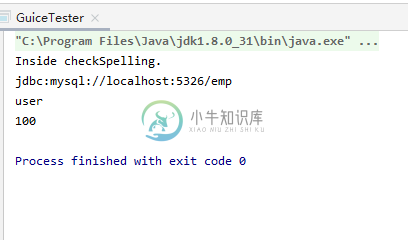Google Guice @Provides
精华
小牛编辑
103浏览
2023-03-14
Google Guice 提供了一种使用 @Provides 注解创建复杂对象绑定的方法。
@Provides
public SpellChecker provideSpellChecker(){
String dbUrl = "jdbc:mysql://localhost:5326/emp";
String user = "user";
int timeout = 100;
SpellChecker SpellChecker = new SpellCheckerImpl(dbUrl, user, timeout);
return SpellChecker;
}
此方法是绑定模块的一部分,并提供要映射的复杂对象。请参阅下面的完整示例。
Google Guice @Provides 完整示例
创建一个名为 GuiceTester 的 Java 类。
GuiceTester.java
package cn.xnip;
import com.google.inject.AbstractModule;
import com.google.inject.Guice;
import com.google.inject.Inject;
import com.google.inject.Injector;
import com.google.inject.Provides;
public class GuiceTester {
public static void main(String[] args) {
Injector injector = Guice.createInjector(new TextEditorModule());
TextEditor editor = injector.getInstance(TextEditor.class);
editor.makeSpellCheck();
}
}
class TextEditor {
private SpellChecker spellChecker;
@Inject
public TextEditor( SpellChecker spellChecker) {
this.spellChecker = spellChecker;
}
public void makeSpellCheck(){
spellChecker.checkSpelling();
}
}
//Binding Module
class TextEditorModule extends AbstractModule {
@Override
protected void configure() {}
@Provides
public SpellChecker provideSpellChecker(){
String dbUrl = "jdbc:mysql://localhost:5326/emp";
String user = "user";
int timeout = 100;
SpellChecker SpellChecker = new SpellCheckerImpl(dbUrl, user, timeout);
return SpellChecker;
}
}
//spell checker interface
interface SpellChecker {
public void checkSpelling();
}
//spell checker implementation
class SpellCheckerImpl implements SpellChecker {
private String dbUrl;
private String user;
private Integer timeout;
@Inject
public SpellCheckerImpl(String dbUrl,
String user,
Integer timeout){
this.dbUrl = dbUrl;
this.user = user;
this.timeout = timeout;
}
@Override
public void checkSpelling() {
System.out.println("Inside checkSpelling." );
System.out.println(dbUrl);
System.out.println(user);
System.out.println(timeout);
}
}
输出
编译并运行该文件,您将看到以下输出。

